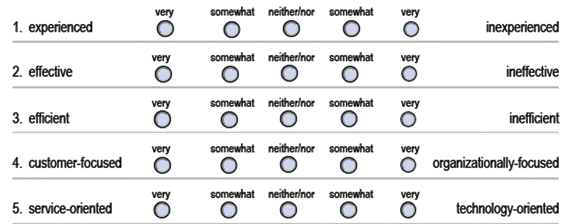The semantic differential technique was developed by Osgood, Suci, and Taneabaum (1957). Its main objective is to examine the meaning of certain concepts, e.g., church, wife, socialism, etc. In a sense, it is an attitude scale.
The groups of subjects may be asked to rate a given concept on a series of bipolar rating scales. Generally, a seven-point scale is utilized, with two ends using opposite adjectives (called bipolar terms), e.g., good-bad, complex-simple, passive-active, friendly-unfriendly, and so on.
The response categories consist of seven categories ranging from one extreme to the other, with the middle category representing neutral. The seven positions for each item are assigned a score from 1 through 7.

Each respondent is then asked to indicate his or her perception of the object by placing a checkmark, that is, by choosing a score on each item that describes the object concerning the bipolar terms for that item.
The individual scores for the items are then summed, and the total score measures the respondent’s perception of the object.
The semantic differential is similar to the Likert scaling categories ranging from strongly disagree to strongly agree, except that only the two end categories have names in the semantic differential.
The middle categories simply have a blank space or sometimes a number.
Also, the two end categories are not strongly agree-strongly disagree, but rather a pair of opposite adjectives (bipolar terms) thought to express the subject’s feelings about the concept.
For example, opinions on the issue of abortion or early marriage may be expressed as good or bad as extremes.
The format for response categories may be displayed as below:

Osgood has investigated the correlations between the scores given to a set concept on different bipolar scales by conducting a series of factor analyses.
The three main factors are;
- Individual evaluation (e.g., social-unsocial, successful-unsuccessful),
- Potency (e.g., weak-strong, heavylight).
- The individual’s activity of the object or concept. (e.g., active-passive, slow-fast)
In other words, people react to various concepts largely (but not entirely) in terms of these dimensions.
The semantic differential makes the measurement and comparison of various objects or concepts possible.
To form an attitude scale, we need to decide the description of the issue to be studied and choose suitable objective pairs for it.
A respondent’s total score is the measure of his attitude.
What is the Semantic Differential Scale?
The Semantic Differential Scale is a survey or questionnaire rating scale that asks respondents to rate a product, company, brand, or entity within a multi-point rating option. The answering options are typically based on opposite adjectives at each end, such as love-hate or satisfied-unsatisfied.
Who invented the Semantic Differential Scale?
The Semantic Differential Scale was invented by Charles Egerton Osgood, an American psychologist, to record the ‘connotative meaning’ of emotional attitudes towards various entities.
What are the three basic dimensions of attitudes revealed by the Semantic Differential Technique?
The three basic dimensions are: (1) Evaluation (e.g., dirty-clean, ugly-beautiful), (2) Potency (e.g., cruel-kind, strong-weak), (3) Activity (e.g., active-passive).
How does the Semantic Differential Scale differ from the Likert Scale?
While both scales are used to gauge respondents’ feelings or attitudes, the Likert scale asks respondents to agree or disagree with a given statement. In contrast, the Semantic Differential Scale invites them to express their emotional perception on a scale between two polarized options, like good-bad.
What are some examples of questions using the Semantic Differential Scale?
Examples include rating a product on criteria like “Inconvenient Appliance” to “Convenient Appliance” or expressing feelings about a job with options ranging from “Absolutely Dissatisfied” to “Completely Satisfied.”
Why is the Semantic Differential Scale considered reliable?
The scale is deemed reliable because it allows respondents to express their opinions more specifically using specific measurements. It provides an objective picture, is easy for respondents to understand, and is simple for interviewers to create.
What should be considered when creating a Semantic Differential Scale questionnaire?
When designing a Semantic Differential Scale questionnaire, it’s essential to use effective scales like evaluation, potency, and activity, ensure the survey’s appearance is appealing, choose the right bipolar adjectives, and consider alternatives if antonyms are challenging to find.